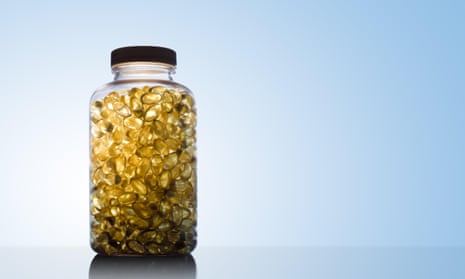More than one in 10 fish oil supplements tested from among 60 large retail brands are rancid, while nearly half are just under the recommended maximum limit, according to independent tests.
Conducted over several years by Labdoor, which analyses vitamins and supplements based on criteria such as purity, label accuracy and nutritional value, the tests measured common US-branded fish oils, available globally, against international voluntary standards of rancidity.
Some fish oils recorded levels 11 times higher than recommended limits.
Rancidity arises when a product becomes oxidised. In fish oil, a rancid example can involve a strong fishy taste and rotten smell.
“It was fairly frequent,” said Dan Mark, Labdoor’s research director. “For us, they would start to smell and feel off.”
The rancidity is often masked by flavourings, which are added to most fish oils to reduce the fishy taste and smell.
Other evaluations are producing similar results. A combination of global studies since 2015 showed that an average of 20% of fish oil products have excess oxidation.
“That means if you go out and buy fish oil, there is at least a one in five chance of you getting an oil more oxidised than the recommended level,” said Dr Ben Albert, fellow at the University of Auckland, whose research focuses on the health effects of fish oil.
Fish oils are extremely popular, particularly in the US, where they are consumed by more than a third of adults who use dietary supplements. They are touted as an alternative to eating fish for getting omega-3 nutrients, and as beneficial for heart disease, improving brain function and strengthening metabolism. Many have flavourings added.

“Flavouring is added to fish oils to help mask fishy smell and taste, and … might make more oxidised oils more palatable for people to take, so it could also be used to hide oxidation of the oil,” said Albert.
Albert said smell was not a reliable indicator of oxidation. “Some fish oils will smell more than others, but if they don’t smell bad, that doesn’t tell you it’s not oxidised,” he said.
Given that the supplement market is largely unregulated, voluntary limits for oxidative quality were created by the Global Organization for EPA and DHA Omega-3 (GOED), an industry body with about 170 members that aims to increase consumption of omega-3s.
The recommended limit was set at 26, an arbitrary and unitless measure of oxidation, and is the most common and strictest worldwide benchmark for fish oil quality. So, the higher the number, the more rancid the oil, though it is important to note that it is an indication of quality, not safety.
The GOED maintains that the majority of its members’ fish oil products are within the limits.
But according to Labdoor’s analysis, conducted on products between 2014 and 2018, fish oils under the brand names Carlson Labs and Puritan’s Pride, which retail in chains such as Walmart and Amazon, had rancidity grades significantly higher than the suggested limits: 281.8 for Carlson’s Norwegian cod liver oil and 37.1 for Puritan Pride’s soft-gel fish oil.
Other brands that exceeded limits were Oceanblue, with an oxidation value of 73.9, and Nature’s Answer, which tested at 34.4. Half of all products tested by Labdoor bordered on the GOED limit, at an average of 24.4.
Oxidation is a normal process in all oils that contain polyunsaturated fatty acids. Fish oil is particularly susceptible to oxidising, which happens faster when exposed to heat, air or light.
It is also prone to oxidisation because of its long supply chain, which often lacks appropriate preventive measures. Most fish oil comes from anchovetas in Peru. Annual catches exceed 4m tonnes, mainly used for aquaculture, with an estimated 38,000 tonnes of anchovy oil extracted for supplements, according to GOED.

Once harvested, the oil is often sent to China for extraction and distillation, before coming back to North America or Europe to be packaged. At each step, the oil must be handled quickly and at low temperatures.
“To prevent oxidation, you have to focus on it from the beginning when the fish is caught, because when the oil is oxidised you can’t restore it back to freshness,” said Bo Martinsen, an omega-3 specialist and co-founder of the fish oil company Omega3 Innovations.
Whether rancid fish oil is harmful remains unclear. So far, sporadic studies have shown that highly oxidised fish oil capsules can have a negative impact on cholesterol levels. When tested in high doses in animals, the oils were shown to have toxic effects.
“It certainly tells us that oxidation changes the way these oils work,” Albert said. “The fact that we know from animals that the effects change when it’s oxidised would mean that a reasonable human consumer would want to avoid oxidised oils – but they can’t do that themselves.”
Whether it is harmful or not, rancid oil is likely to be less effective than fresh fish oil, according to Martinsen. He points to changes in the chemical composition of highly oxidised oils that may reduce their benefits. Again, however, the research is not conclusive.
The GOED has been pushing back on criticism for years. After a 2015 study by Albert noted that 92% of products in New Zealand exceeded one of the recommended oxidation limits, it conducted its own replication study in 2017 and the results were much lower, with less than 20% of the products exceeding the limits.
Gerard Bannenberg, director of technical compliance at GOED, said: “I don’t think people need to be concerned about oxidation. The level we’re talking about is very low. Even if the product is slightly oxidised, it’s very unlikely that it will harm our health.”
Only Nature’s Answer responded to the Guardian’s request for comment, maintaining that typical results for their fish oil ranges have a total oxidation value of 10. Any results over 25, such as in Labdoor’s tests, indicate improper handling and storage, they say, which is likely to be in the supply chain before being tested.
Albert said: “The GOED recommended limit is not a magical number that means something important for how that pill will act in your body. In principle, we should have regulatory levels at which health effects change, but we don’t know those levels.”
In general, he warned, fish oil supplements are hard to trust.



